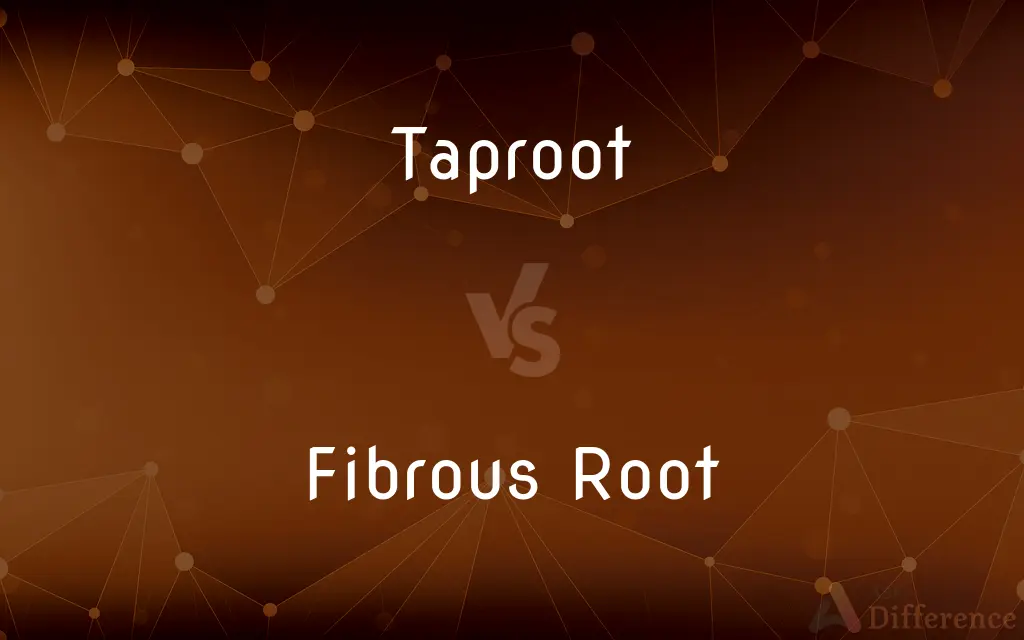Taproot vs. Fibrous Root — What's the Difference?
Edited by Tayyaba Rehman — By Fiza Rafique — Published on December 21, 2023
Taproot is a single, main root that grows deeper while fibrous roots are thin, branching roots spreading out from the stem.

Difference Between Taproot and Fibrous Root
Table of Contents
ADVERTISEMENT
Key Differences
Taproot originates directly from the radicle of the germinating seed, while fibrous roots develop from the base of the stem.
Taproot is generally more prominent and thicker than the rest of its subsidiary roots, while fibrous roots are all more or less of the same size.
Taproot goes deeper into the soil in search of water and nutrients, whereas fibrous roots stay near the soil surface and spread outwards.
Taproot is common in dicotyledonous plants, and fibrous roots are typical of monocotyledonous plants.
Taproot often has lateral or secondary roots branching off, while fibrous roots have a network of similar-sized roots without a primary one.
ADVERTISEMENT
Comparison Chart
Origin
From radicle of seed
From base of stem
Size & Shape
Main root thicker & prominent
All roots of similar size
Depth
Goes deeper into soil
Stays near soil surface
Typical Plants
Dicotyledonous
Monocotyledonous
Secondary Roots
Has lateral roots branching off
Lacks a primary root; network of similar roots
Compare with Definitions
Taproot
The primary root that emerges directly from a seed.
The carrot plant has a taproot that we eat as a vegetable.
Fibrous Root
A network of similarly sized roots without a dominant one.
Onions have fibrous roots that fan out in the soil.
Taproot
A central root from which secondary roots sprout.
The taproot of the tree anchors it firmly into the ground.
Fibrous Root
Roots that emerge from the stem's base.
The fibrous roots of maize plants help stabilize them in the soil.
Taproot
A root that serves as the primary storage organ.
Beets store their nutrients in the taproot.
Fibrous Root
A shallow root system found in monocots.
Wheat plants possess a fibrous root system.
Taproot
A deep-rooted system dominant in dicots.
Dandelions have a taproot, making them hard to uproot.
Fibrous Root
A complex of thin, finely branching roots.
Grasses typically have a fibrous root system.
Taproot
The main root that penetrates deep into the soil.
Due to its taproot, the oak tree can access water from deeper layers of the soil.
Fibrous Root
Roots that spread out horizontally in the soil.
The fibrous roots of turf grass create a dense mat in the topsoil.
Taproot
The main root of a plant, usually stouter than the lateral roots and growing straight downward from the stem.
Taproot
(botany) A long, tapering root possessed by many plants (such as carrots and dandelions).
Taproot
The root of a plant which penetrates the earth directly downward to a considerable depth without dividing.
Taproot
(botany) main root of a plant growing straight downward from the stem
Taproot
Something that provides an important central source for growth or development;
The taproot of his resentment
Genius and insanity spring from the same taproot
Common Curiosities
What is a taproot?
A taproot is the main, central root that emerges directly from a seed and grows deeper than the rest.
Where does the taproot originate from?
The taproot originates from the radicle of the germinating seed.
What plants typically have taproots?
Dicotyledonous plants, like carrots and dandelions, typically have taproots.
Do fibrous roots come from a seed's radicle?
No, fibrous roots develop from the base of the stem.
What is a fibrous root?
A fibrous root is a complex of thin, finely branching roots that spread out from the stem's base.
Which is deeper, taproot or fibrous root?
Taproot goes deeper into the soil, while fibrous roots are more superficial.
What plants typically have fibrous roots?
Monocotyledonous plants, like grasses and wheat, have fibrous roots.
Why is it hard to pull out dandelions?
Dandelions have a deep taproot, which makes them challenging to uproot entirely.
Why are taproots sometimes thick and fleshy?
Some taproots are modified to store nutrients, making them thick and fleshy.
Do fibrous roots store nutrients?
Generally, fibrous roots are not primary storage organs, unlike some taproots.
Can plants have both taproot and fibrous root systems?
Typically, a plant will have either a taproot or a fibrous root system, not both.
Do onions have taproots?
No, onions have a fibrous root system.
How does a taproot benefit plants?
Taproots anchor plants deeply and access water and nutrients from deeper soil layers.
Is the carrot we eat a root?
Yes, the carrot we eat is an example of a taproot.
How do fibrous roots benefit plants?
Fibrous roots provide stability and can quickly absorb water and nutrients from the topsoil.
Share Your Discovery

Previous Comparison
Cast Iron vs. Cast Steel
Next Comparison
Exothermic Reaction vs. Endothermic ReactionAuthor Spotlight
Written by
Fiza RafiqueFiza Rafique is a skilled content writer at AskDifference.com, where she meticulously refines and enhances written pieces. Drawing from her vast editorial expertise, Fiza ensures clarity, accuracy, and precision in every article. Passionate about language, she continually seeks to elevate the quality of content for readers worldwide.
Edited by
Tayyaba RehmanTayyaba Rehman is a distinguished writer, currently serving as a primary contributor to askdifference.com. As a researcher in semantics and etymology, Tayyaba's passion for the complexity of languages and their distinctions has found a perfect home on the platform. Tayyaba delves into the intricacies of language, distinguishing between commonly confused words and phrases, thereby providing clarity for readers worldwide.












































